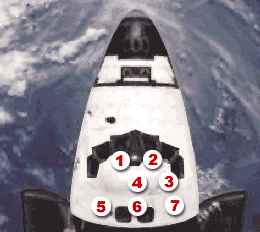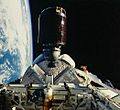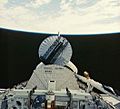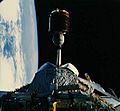STS-41-D facts for kids
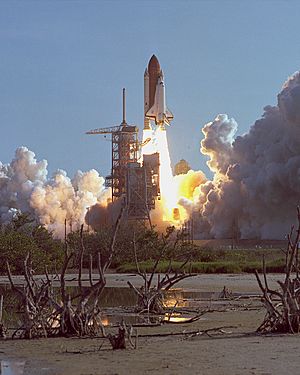
The launch of Space Shuttle Discovery on its first mission on 30 August 1984.
|
|
| Names | Space Transportation System-12 |
|---|---|
| Mission type | Satellites deployment |
| Operator | NASA |
| Mission duration | 6 days, 0 hour, 56 minutes, 4 seconds (achieved) |
| Distance travelled | 4,010,000 km (2,490,000 mi) |
| Orbits completed | 97 |
| Spacecraft properties | |
| Spacecraft | Space Shuttle Discovery |
| Launch mass | 119,511 kg (263,477 lb) |
| Landing mass | 91,418 kg (201,542 lb) |
| Payload mass | 18,681 kg (41,185 lb) |
| Crew | |
| Crew size | 6 |
| Members |
|
| Start of mission | |
| Launch date | 30 August 1984, 12:41:50 UTC |
| Rocket | Space Shuttle Discovery |
| Launch site | Kennedy Space Center, LC-39A |
| Contractor | Rockwell International |
| End of mission | |
| Landing date | 5 September 1984, 13:37:54 UTC |
| Landing site | Edwards Air Force Base, Runway 17 |
| Orbital parameters | |
| Reference system | Geocentric orbit |
| Regime | Low Earth orbit |
| Perigee | 346 km (215 mi) |
| Apogee | 354 km (220 mi) |
| Inclination | 28.50° |
| Period | 90.60 minutes |
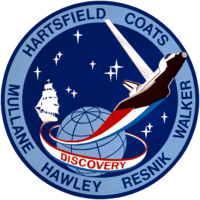 STS-41-D mission patch 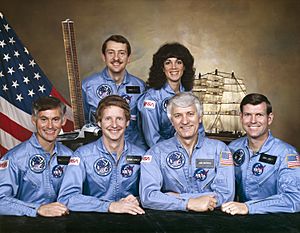 Back row: Charles D. Walker, Judith A. Resnik Front row: Richard M. Mullane, Steven A. Hawley, Henry W. Hartsfield Jr., Michael L. Coats |
|
STS-41-D was a space mission by NASA's Space Shuttle program. It was the 12th flight of a Space Shuttle and the very first mission for Space Shuttle Discovery. The mission launched from Kennedy Space Center, Florida, on August 30, 1984. It landed at Edwards Air Force Base, California, on September 5, 1984.
During this six-day trip, the crew put three important communication satellites into orbit. They also did several science experiments. One key experiment tested a new type of extendable solar array. This design later helped create the main solar panels for the International Space Station (ISS). The mission was supposed to launch much earlier, but it faced delays. It even had the Space Shuttle program's first launch stop just seconds before liftoff.
Contents
Meet the Crew
The STS-41-D mission had a crew of six astronauts. They were all very important for the success of the flight.
| Position | Astronaut | |
|---|---|---|
| Commander | Henry W. Hartsfield Jr. Second spaceflight |
|
| Pilot | Michael L. Coats First spaceflight |
|
| Mission Specialist 1 | Richard M. Mullane First spaceflight |
|
| Mission Specialist 2 | Steven A. Hawley First spaceflight |
|
| Mission Specialist 3 | Judith A. Resnik First spaceflight |
|
| Payload Specialist 1 | Charles D. Walker First spaceflight |
|
Where the Crew Sat
The astronauts had specific seats for launch and landing. Some seats were on the Flight Deck, which is like the cockpit. Others were on the Middeck, a lower area.
| Seat | Launch | Landing |
Seats 1–4 are on the Flight Deck. Seats 5–7 are on the Middeck. |
|---|---|---|---|
| S1 | Hartsfield | Hartsfield | |
| S2 | Coats | Coats | |
| S3 | Mullane | Resnik | |
| S4 | Hawley | Hawley | |
| S5 | Resnik | Mullane | |
| S6 | Walker | Walker |
Mission Delays
The launch of STS-41-D was originally planned for June 25, 1984. However, it was delayed for over two months. This happened because of several technical problems. For example, the shuttle had to be moved back to the Vehicle Assembly Building (VAB) to replace a main engine that wasn't working right.
June 1984 Launch Attempt
On June 26, 1984, the shuttle almost launched. But at T-6 seconds (meaning 6 seconds before liftoff), the launch was stopped. This is called a "launch abort." About ten minutes later, a small fire started on the launch pad.
The problem was that one of the main engines didn't start correctly. This caused some confusion for the flight controllers. They weren't sure if the engine had shut down or not.
After the abort, Mission Specialist Steve Hawley joked, "Gee, I thought we'd be a lot higher at MECO (Main Engine Cut-Off)!"
Later, water was sprayed onto the engine area. This was because a hydrogen fire had started. Hydrogen fuel had gathered around the engines after they shut down. The fire was hard to see, so if the astronauts had used their usual escape route, they might have run into it.
Because of this incident, NASA made changes to their procedures. They practiced more ways to make the shuttle safe after an abort. They also decided to use the fire suppression system (the water spray) during all pad aborts. They even tested the emergency escape system with a real person. This helped them make sure it was safe for astronauts to use. Engineers later found that a stuck valve caused the engine problem. This valve stopped the fuel from flowing properly.
Mission Highlights
STS-41-D finally launched at 8:41:50 a.m. EDT on August 30, 1984. There was a short delay because a private plane flew into the restricted area near the launch pad. This was the fourth time they tried to launch Discovery.
Because of the two-month delay, another planned mission, STS-41-F, was canceled. Its main cargo was added to the STS-41-D flight. This made the combined cargo weigh over 18,681 kg (41,185 lb). This was a record for the heaviest Space Shuttle payload at that time!
The six-person crew included Commander Henry W. Hartsfield Jr., who was on his second shuttle mission. The pilot was Michael L. Coats. There were three mission specialists: Judith A. Resnik, Richard M. Mullane, and Steven A. Hawley. Charles D. Walker was a payload specialist. He was the first person sponsored by a company to fly on the Space Shuttle. Judith Resnik became the second American woman to fly in space for NASA, after Sally K. Ride.
The main cargo on Discovery included three commercial communications satellites. These were SBS-4, Telstar 302, and Syncom IV-2 (also called Leasat-2). All three satellites were built by Hughes Aircraft Company. Leasat-2 was special because it was the first large communication satellite designed to be launched from the Space Shuttle. All three satellites were successfully put into orbit and started working.
Another important payload was the OAST-1 solar array. This device was 4 m (13 ft) wide and 31 m (102 ft) long. It could fold up into a small package only 18 cm (7.1 in) deep. The array had different types of experimental solar cells. The crew extended it to its full length several times during the mission. At that time, it was the largest structure ever extended from a crewed spacecraft. It showed that large, lightweight solar arrays could work for future space stations, like the ISS.
The crew also ran an experiment called the Continuous Flow Electrophoresis System (CFES). This experiment used living cells. Payload specialist Charles Walker worked on it for over 100 hours during the flight. A student experiment to study crystal growth in microgravity (very low gravity) was also done.
The best parts of the mission were filmed using an IMAX motion picture camera. These clips later appeared in the 1985 documentary film The Dream is Alive.
During the mission, a strange thing happened. A 61 cm (24 in) "pee-sicle" (a frozen chunk of wastewater) formed outside the shuttle. This was because of a blockage in the shuttle's wastewater dumping system. Commander Hartsfield used the robotic arm (Canadarm) to remove it.
The mission lasted 6 days, 0 hours, 56 minutes, and 4 seconds. Discovery landed on Runway 17 at Edwards Air Force Base on September 5, 1984. During STS-41-D, Discovery traveled a total of 4,010,000 km (2,490,000 mi) and completed 97 orbits around Earth. The shuttle was then flown back to Kennedy Space Center on September 10, 1984.
After the mission, engineers found a small amount of soot beyond the main O-ring in one of the Solid Rocket Boosters (SRBs). This was a sign of "blow-by damage." Later, an engineer named Brian Russell called this finding the first "big red flag" about the safety of the SRB joints and O-rings. This discovery helped engineers understand important safety issues for future space flights.
Launch Attempts Timeline
This table shows the different attempts to launch STS-41-D.
| Attempt | Planned | Result | Turnaround | Reason | Decision point | Weather go (%) | Notes |
|---|---|---|---|---|---|---|---|
| 1 | 25 Jun 1984, 12:00:00 am | scrubbed | — | A backup computer failed, so the launch was stopped. | (T-9:00 minutes and holding) | ||
| 2 | 26 Jun 1984, 12:00:00 am | scrubbed | 1 day, 0 hours, 0 minutes | The launch was stopped 6 seconds before liftoff because of a problem with one of the main engines. | (T-0:06) | Discovery had to go back for engine replacement, delaying the launch by over two months. | |
| 3 | 29 Aug 1984, 12:00:00 am | scrubbed | 64 days, 0 hours, 0 minutes | A problem with a controller related to rocket engine commands. | |||
| 4 | 30 Aug 1984, 1:41:50 pm | successful | 1 day, 13 hours, 42 minutes | The launch was delayed by 6 minutes and 50 seconds because a private plane flew into the restricted airspace near the launch site. |
Mission Patch
The mission patch for STS-41-D has 12 stars in a blue background. These stars show that the flight was originally called STS-12. The patch also shows a sailing ship, which represents Discovery's name. This ship is connected to the Space Shuttle (which has the OAST solar array in its cargo bay) by a red, white, and blue path. This path symbolizes Discovery's first journey into space.
Wake-up Calls
Since the Project Gemini missions, NASA has had a tradition of playing music to wake up astronauts in space. This started with Apollo 15. Each song is chosen carefully, often by the astronauts' families. The songs usually have a special meaning to one of the crew members or relate to what they will be doing that day.
| Flight Day | Song | Artist/Composer |
|---|---|---|
| Day 2 | "Anchors Aweigh" | Charles A. Zimmerman |
| Day 3 | "Telstar" | The Ventures |
| Day 4 | "Mr. Spaceman" | The Byrds |
| Day 5 | "Hair" | Broadway cast |
| Day 6 | "Eight Miles High" | The Byrds |
Images for kids
See also
 In Spanish: STS-41-D para niños
In Spanish: STS-41-D para niños


